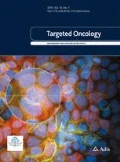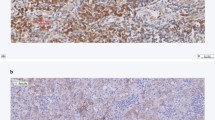Abstract
Invasive micropapillary urothelial carcinomas (MPUC) emerge at higher stages and follow a more aggressive course than conventional invasive urothelial carcinomas (UC). Little is known about the target therapies using tyrosine kinase inhibitors in MPUC. This study is to investigate potential effectiveness of tyrosine kinase receptor inhibitors by determining expression of epidermal growth factor receptor (EGFR), human epidermal receptor 2 (HER2), and vascular endothelial growth factor receptor 2 (VEGFR) proteins in MPUC and UC. 16 cases of MPUC and 16 stage-matched UC were identified. Immunohistochemistry for EGFR, HER2, and VEGFR2 and HER2 gene amplification by fluorescence in situ hybridization (FISH) were performed. HER2 and EGFR proteins were expressed in MPUC and UC, with significantly higher HER2 expression in MPUC (ratio 1.82, p < 0.01). HER2 gene amplification was identified in 4 of 16 MPUC (25 %). Amplification was limited to cases with 3+ HER2 expression (100 % concordance). EGFR expression in MPUC was slightly higher than UC but not statistically significant (ratio 1.57, p = 0.19). EGFR and HER2 coexpression was noted in 75 % of MPUC and 37.5 % of UC. No VEGFR expression was identified in the urothelium. Strong VEGFR expression was noted in stromal vessels in both MPUC and UC. In conclusion, EGFR and HER2 are potential targets for neoadjuvant chemotherapy in MPUC and UC. There is no direct anti-tumor effect expected for VEGFR inhibitors.



Similar content being viewed by others
References
Amin MB, Ro JY, el-Sharkawy T et al (1994) Micropapillary variant of transitional cell carcinoma of the urinary bladder. Histologic pattern resembling ovarian papillary serous carcinoma. Am J Surg Pathol 18(12):1224–1232
Kamat AM, Dinney CP, Gee JR et al (2007) Micropapillary bladder cancer: a review of the University of Texas M. D. Anderson Cancer Center experience with 100 consecutive patients. Cancer 110:62–67
Kamat AM, Gee JR, Dinney CP et al (2006) The case for early cystectomy in the treatment of nonmuscle invasive micropapillary bladder carcinoma. J Urol 175:881–885
Samaratunga H, Khoo K (2004) Micropapillary variant of urothelial carcinoma of the urinary bladder: a clinicopathological and immunohistochemical study. Histopathology 45:55–64
Ghoneim IA, Miocinovic R, Stephenson AJ et al (2011) Neoadjuvant systemic therapy or early cystectomy? Single-center analysis of outcomes after therapy for patients with clinically localized micropapillary urothelial carcinoma of the bladder. Urology 77:867–870
Lopez-Beltran A, Montironi R, Blanca A et al (2010) Invasive micropapillary urothelial carcinoma of the bladder. Hum Pathol 41:1159–1164
Grossman HB, Natale RB, Tangen CM et al (2003) Neoadjuvant chemotherapy plus cystectomy compared with cystectomy alone for locally advanced bladder cancer. N Engl J Med 349(9):859–866
International Collaboration of Trialists (2011) International phase III trial assessing neoadjuvant cisplatin, methotrexate, and vinblastine chemotherapy for muscle-invasive bladder cancer: long-term results of the BA06 30894 trial. J Clin Oncol 29(16):2171–2177
Meeks JJ, Taylor JM, Matsushita K et al (2013) Pathological response to neoadjuvant chemotherapy for muscle-invasive micropapillary bladder cancer. BJU Int 111(8):E325–E330
Willis DL, Fernandez M, Dickstein, RJ, et al. (2013) Outcome of patients with micropapillary bladder cancer treated with neoadjuvant therapy and radical cystectomy. J Clin Oncol 31, suppl 6: abstr 318
Canvasser N, Weizer A, Crossley H, et al. (2014) Micropapillary Differentiation Versus Conventional Urothelial Carcinoma: Effects Of Neoadjuvant Chemotherapy And Cystectomy On Survival. AUA 2014 conference, abstract MP50-06.
Watts KE, Hansel DE (2010) Emerging concepts in micropapillary urothelial carcinoma. Adv Anat Pathol 17(3):182–186
Nassar H (2004) Carcinomas with micropapillary morphology: clinical significance and current concepts. Adv Anat Pathol 11(6):297–303
Amin A, Epstein JI (2012) Noninvasive micropapillary urothelial carcinoma: a clinicopathologic study of 18 cases. Hum Pathol 43(12):2124–2128
Sangoi AR, Beck AH, Amin MB et al (2010) Interobserver reproducibility in the diagnosis of invasive micropapillary carcinoma of the urinary tract among urologic pathologists. Am J Surg Pathol 34(9):1367–1376
Siefker-Radtke AO, Dinney CP, Shen Y et al (2013) A phase 2 clinical trial of sequential neoadjuvant chemotherapy with ifosfamide, doxorubicin, and gemcitabine followed by cisplatin, gemcitabine, and ifosfamide in locally advanced urothelial cancer: final results. Cancer 119(3):540–547
Willis DL, Flaig TW, Hansel DE et al (2014) Micropapillary bladder cancer: current treatment patterns and review of the literature. Urol Oncol 32(6):826–832
Perepletchikov AM, Parwani AV (2009) Micropapillary urothelial carcinoma: clinico-pathologic review. Pathol Res Pract 205(12):807–810
Amin MB (2009) Histological variants of urothelial carcinoma: diagnostic, therapeutic and prognostic implications. Mod Pathol 22(Suppl 2):S96–S118
Compérat E, Roupret M, Conort P et al (2009) Aurora-A/STK-15 is differentially expressed in the micropapillary variant of bladder cancer. Urol Int 82(3):312–317
Sen S, Zhou H, Zhang RD et al (2002) Amplification/overexpression of a mitotic kinase gene in human bladder cancer. J Natl Cancer Inst 94(17):1320–1329
Jimenez RE, Hussain M, Bianco FJ Jr et al (2001) Her-2/neu overexpression in muscle-invasive urothelial carcinoma of the bladder: prognostic significance and comparative analysis in primary and metastatic tumors. Clin Cancer Res 7(8):2440–2447
Bolenz C, Shariat SF, Karakiewicz PI et al (2010) Human epidermal growth factor receptor 2 expression status provides independent prognostic information in patients with urothelial carcinoma of the urinary bladder. BJU Int 106(8):1216–1222
Naruse K, Yamada Y, Nakamura K et al (2010) Potential of molecular targeted therapy of HER-2 and Cox-2 for invasive transitional cell carcinoma of the urinary bladder. Oncol Rep 23(6):1577–1583
Jalali Nadoushan MR, Taheri T, Jouian N et al (2007) Overexpression of HER-2/neu oncogene and transitional cell carcinoma of bladder. Urol J 4(3):151–154
Skagias L, Politi E, Karameris A et al (2009) Prognostic impact of HER2/neu protein in urothelial bladder cancer. Survival analysis of 80 cases and an overview of almost 20 years’ research. J BUON 14(3):457–462
Kim TS, Rhew HY, Hwang HY (2011) Pilot study of the clinical significance of serum and urinary her-2/neu protein in bladder cancer patients. Korean J Urol 52(12):815–818
De Pinieux G, Colin D, Vincent-Salomon A et al (2004) Confrontation of immunohistochemistry and fluorescent in situ hybridization for the assessment of HER-2/neu (c-erbb-2) status in urothelial carcinoma. Virchows Arch 444(5):415–419
Caner V, Turk NS, Duzcan F et al (2008) No strong association between HER-2/neu protein overexpression and gene amplification in high-grade invasive urothelial carcinomas. Pathol Oncol Res 14(3):261–266
Simonetti S, Russo R, Ciancia G et al (2009) Role of polysomy 17 in transitional cell carcinoma of the bladder: immunohistochemical study of HER2/neu expression and fish analysis of c-erbB-2 gene and chromosome 17. Int J Surg Pathol 17(3):198–205
Coogan CL, Estrada CR, Kapur S et al (2004) HER-2/neu protein overexpression and gene amplification in human transitional cell carcinoma of the bladder. Urology 63(4):786–790
Sangoi AR, Higgins JP, Rouse RV et al (2009) Immunohistochemical comparison of MUC1, CA125, and Her2Neu in invasive micropapillary carcinoma of the urinary tract and typical invasive urothelial carcinoma with retraction artifact. Mod Pathol 22(5):660–667
Ching CB, Amin MB, Tubbs RR et al (2011) HER2 gene amplification occurs frequently in the micropapillary variant of urothelial carcinoma: analysis by dual-color in situ hybridization. Mod Pathol 24(8):1111–1119
Hussain MH, MacVicar GR, Petrylak DP et al (2007) Trastuzumab, paclitaxel, carboplatin, and gemcitabine in advanced human epidermal growth factor receptor-2/neu-positive urothelial carcinoma: results of a multicenter phase II National Cancer Institute trial. J Clin Oncol 25(16):2218–2224
Yamada Y, Naruse K, Nakamura K et al (2007) Potential for molecular-targeted therapy targeting human epidermal growth factor receptor-2 for invasive bladder cancer. Oncol Rep 18(1):3–7
Matsubara H, Yamada Y, Naruse K et al (2008) Potential for HER-2/neu molecular targeted therapy for invasive bladder carcinoma: comparative study of immunohistochemistry and fluorescent in situ hybridization. Oncol Rep 19(1):57–63
Salzberg M, Borner M, Bauer JA et al (2006) Trastuzumab (Herceptin) in patients with HER-2-overexpressing metastatic or locally advanced transitional cell carcinoma of the bladder: report on 7 patients. Eur J Cancer 42(15):2660–2661
Ross JS, Wang K, Gay LM et al (2014) A high frequency of activating extracellular domain ERBB2 (HER2) mutation in micropapillary urothelial carcinoma. Clin Cancer Res 20(1):68–75
Sharma SV, Bell DW, Settleman J et al (2007) Epidermal growth factor receptor mutations in lung cancer. Nat Rev Cancer 7(3):169–181
Mattila AL, Perheentupa J, Pesonen K et al (1985) Epidermal growth factor in human urine from birth to puberty. J Clin Endocrinol Metab 61(5):997–1000
Chow NH, Liu HS, Lee EIC et al (1997) Significance of urinary epidermal growth factor and its receptor expression in human bladder cancer. Anticancer Res 17(2B):1293–1296
Tsai YS, Cheng HL, Tzai TS et al (2012) Clinical significance of ErbB receptor family in urothelial carcinoma of the bladder: a systematic review and meta-analysis. Adv Urol 181964
Balar AV, Milowsky MI (2012) Novel agents in invasive urothelial cancer. Clin Adv Hematol Oncol 10(8):504–516
Wülfing C, Machiels JP, Richel DJ et al (2009) A single-arm, multicen-ter, open-label phase 2 study of lapatinib as the second-line treatment of patients with locally advanced or metastatic transitional cell carcinoma. Cancer 115(13):2881–2890
Chaux A, Cohen JS, Schultz L et al (2012) High epidermal growth factor receptor immunohistochemical expression in urothelial carcinoma of the bladder is not associated with EGFR mutations in exons 19 and 21: a study using formalin-fixed, paraffin-embedded archival tissues. Hum Pathol 43(10):1590–1595
Olayioye MA, Graus-Porta D, Beerli RR et al (1998) ErbB-1 and ErbB-2 acquire distinct signaling properties dependent upon their dimerization partner. Mol Cell Biol 18(9):5042–5051
Grivas PD, Day M, Hussain M (2011) Urothelial carcinomas: a focus on human epidermal receptors signaling. Am J Transl Res 3(4):362–373
Siefker-Radtke AO, Kamat AM, Corn PG, et al. (2012) Neoadjuvant chemotherapy with DD-MVAC and bevacizumab in high risk urothelial cancer: results from a phase II trial at the MD Anderson Cancer Center. J Clin Oncol (ASCO Annual Proceedings) 30 (18 Suppl): Abstract 261
Gallagher DJ, Milowsky MI, Gerst SR et al (2010) Phase II study of sunitinib in patients with metastatic urothelial cancer. J Clin Oncol 28(8):1373–1379
Necchi A, Zaffaroni N, Mariani L, et al. (2012) Biomarker analysis and final results of INT70/90 Phase II prrof-of-concept of Pazopanib (PZP) in refractory urothelial cancer (UC). Proceedings of the 2012 American Association of Cancer Research Annual Meeting; Chicago, IL: March31-April 4, 2012. Abstract LB-433
Balar AV, Apolo AB, Ostrovnaya I et al (2013) Phase II study of gemcitabine, carboplatin, and bevacizumab in patients with advanced unresectable or metastatic urothelial cancer. J Clin Oncol 31(6):724–30
Sonpavde G, Jian W, Liu H et al (2009) Sunitinib malate is active against human urothelial carcinoma and enhances the activity of cisplatin in a preclinical model. Urol Oncol 27(4):391–399
Xia G, Kumar SR, Hawes D et al (2006) Expression and significance of vascular endothelial growth factor receptor 2 in bladder cancer. J Urol 175(4):1245–1252
Gakiopoulou-Givalou H, Nakopoulou L, Panayotopoulou EG et al (2003) Non-endothelial KDR/flk-1 expression is associated with increased survival of patients with urothelial bladder carcinomas. Histopathology 43:272–279
Potapova O, Laird AD, Nannini MA et al (2006) Contribution of individual targets to the antitumor efficacy of the multitargeted receptor tyrosine kinase inhibitor SU11248. Mol Cancer Ther 5(5):1280–1289
Papaetis GS, Syrigos KN (2009) Sunitinib: a multitargeted receptor tyrosine kinase inhibitor in the era of molecular cancer therapies. BioDrugs 23(6):377–389
Chow LQ, Eckhardt SG (2007) Sunitinib: from rational design to clinical efficacy. J Clin Oncol 25(7):884–896
Conflicts of interest
No conflict of interest is claimed.
Author information
Authors and Affiliations
Corresponding author
Rights and permissions
About this article
Cite this article
Li, J., Jackson, C.L., Yang, D. et al. Comparison of tyrosine kinase receptors HER2, EGFR, and VEGFR expression in micropapillary urothelial carcinoma with invasive urothelial carcinoma. Targ Oncol 10, 355–363 (2015). https://doi.org/10.1007/s11523-014-0341-x
Received:
Accepted:
Published:
Issue Date:
DOI: https://doi.org/10.1007/s11523-014-0341-x




